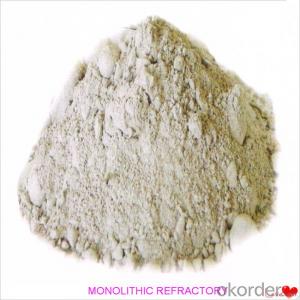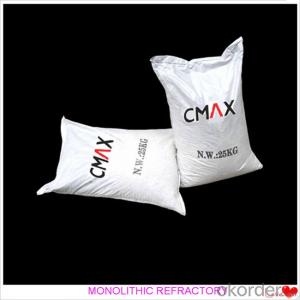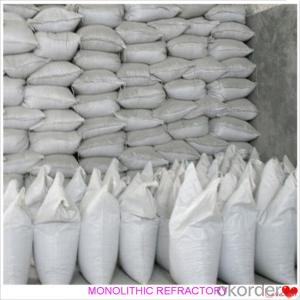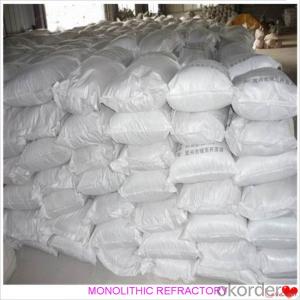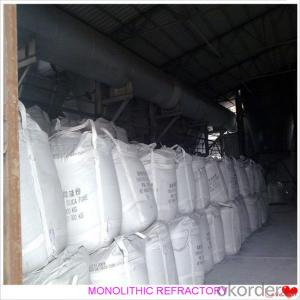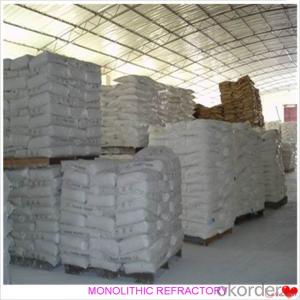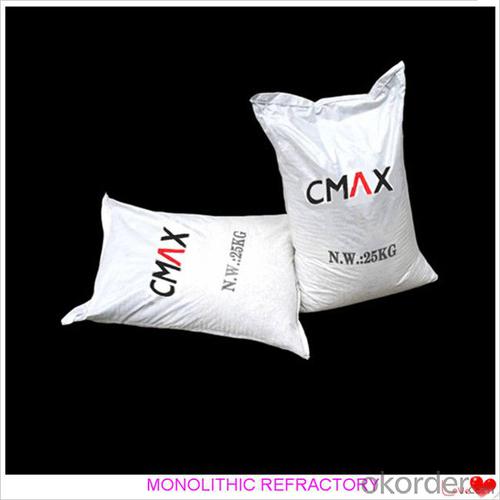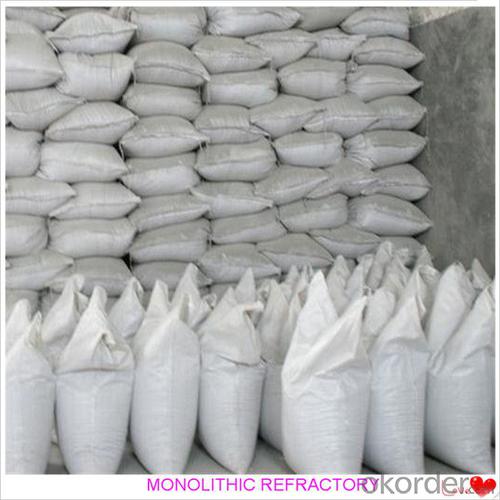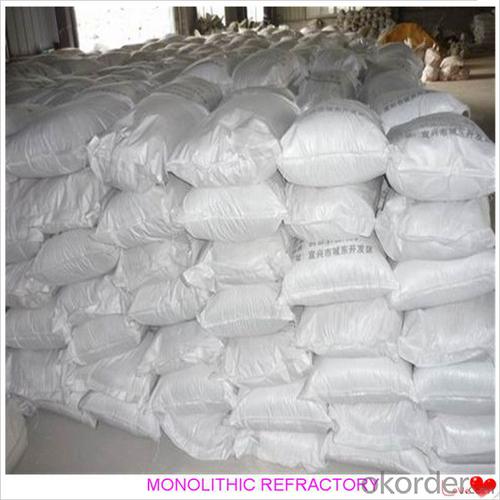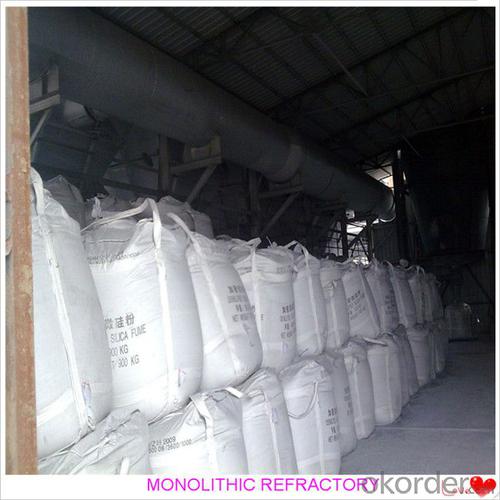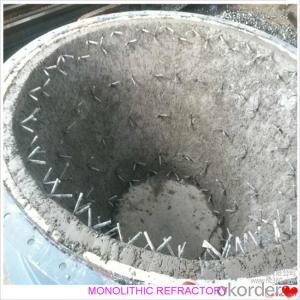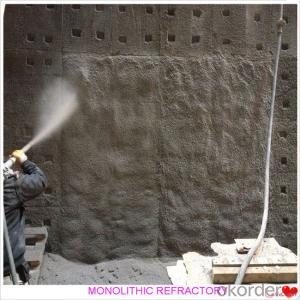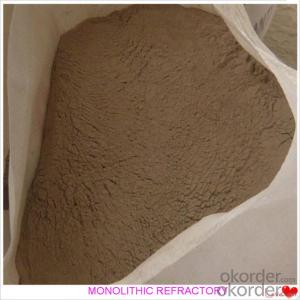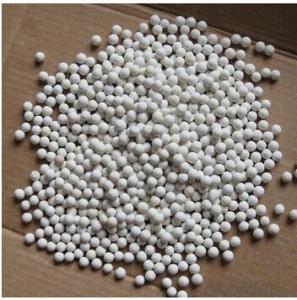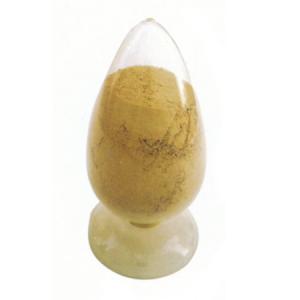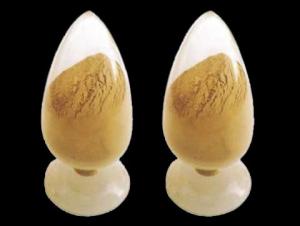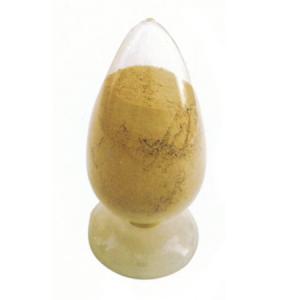Monolithic Refractories for Iron and Steel Industry:Corundum Castable for Fireplace and Industrial Furnace
- Loading Port:
- China main port
- Payment Terms:
- TT OR LC
- Min Order Qty:
- 100 kg
- Supply Capability:
- 3000000 kg/month
OKorder Service Pledge
OKorder Financial Service
You Might Also Like
Corundum Castable For Fireplace and Industrial Furnace in Iron and Steel
Product Description:
Corundum castable is manufactured according to international standards. The product is famous for its excellent abrasion resistance and low thermal conductivity. Further, these can be provided in different specifications as required by the clients. The Corundum castables are used high purity raw materials and additives as the main material, and made of under superfine powder adding technology.
Product Advantages:
The material has excellent structural stability and air tightness, and has high physical and chemical properties, also has a fine working ability.They should be used with the same material products.
Product Applications:
For feature of Corundum castable, they have excellent abrasion resistance, thermal shock resistance, high-temperature resistance, anti-corrode and have high intensity.
Designed for refractory lining of blast furnace iron and slag runners, skimmers and soon
They can be used in troughs of small and mid size BFs and in all positions of the troughs where fast tapping is required.
Product Specifications:
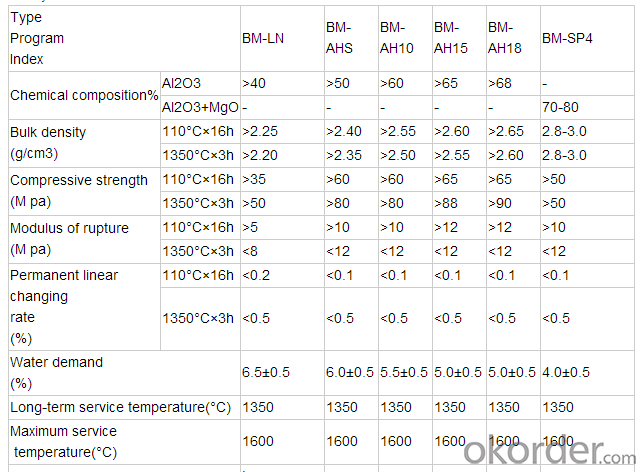
FAQ:
1. How you can control your quality?
For each production processing, we have complete QC system for the chemical composition
and Physical properties. After production, all the goods will be tested, and the quality certificate
will be shipped along with goods.
2. What's your delivery time?
It usually needs about 20days- 45 days after receiving the deposit.
3. Do you provide free samples?
Yes, we can provide a free sample for testing, If we have sample in stock,
The quantity based on the material type, The buyer should bear all the shipping costs.
4. What's your payment terms?
We can accept 30% deposit, 70% balance before shipment for ordrs over $ 2000.
5. Can we visit your Company?
Yes, certainly. You are very welcome to China and we will be honored to have a customer and friend.
Product Picture:
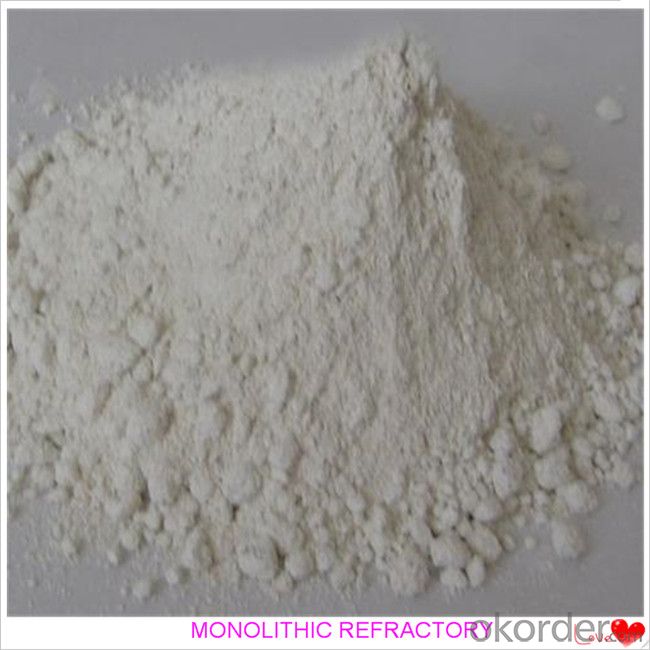
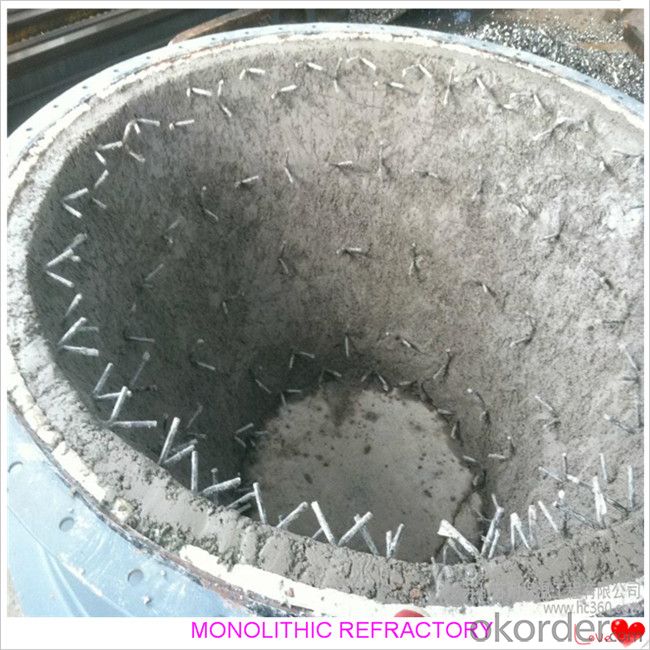
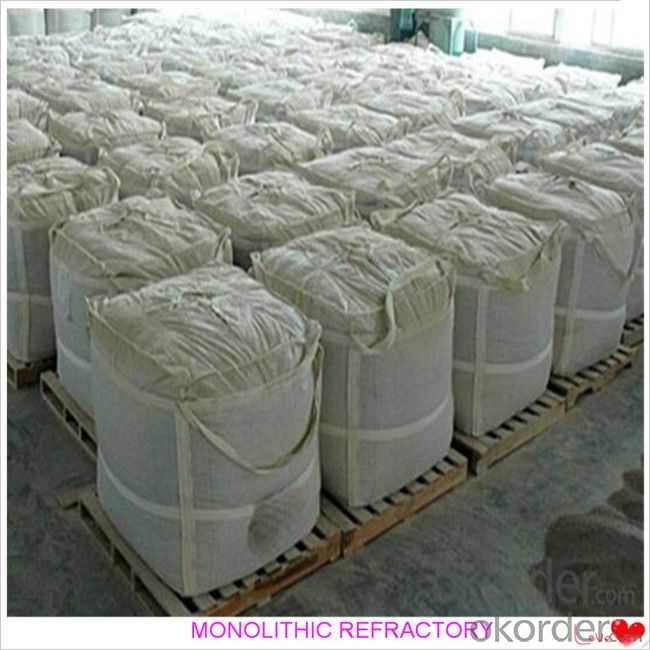
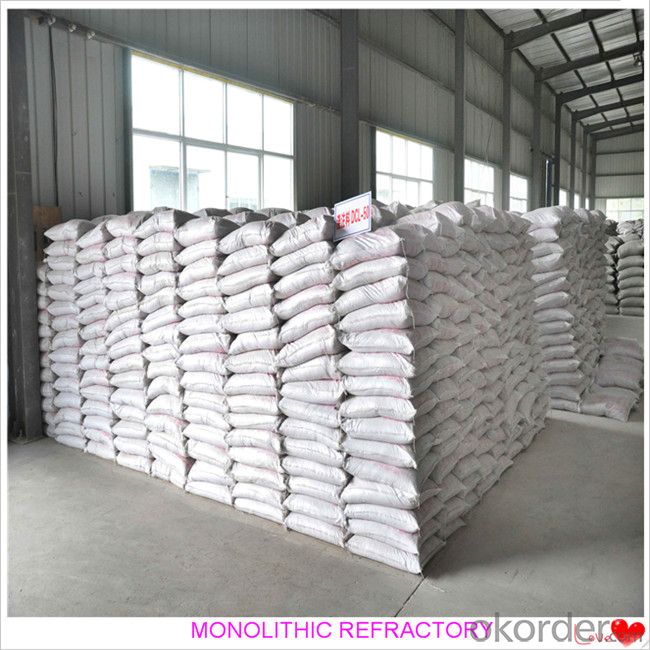
- Q: How do monolithic refractories resist abrasion in the iron and steel industry?
- Monolithic refractories are specifically designed to resist abrasion in the iron and steel industry due to their unique composition and properties. These refractories are made from a single homogeneous material, which allows them to exhibit exceptional strength and durability when subjected to continuous abrasion. One of the key factors that contribute to the abrasion resistance of monolithic refractories is their high density. These refractories are manufactured with tightly packed particles, ensuring a solid and compact structure. This density helps to minimize wear and tear caused by the constant movement of materials, such as iron and steel, within the industry. Additionally, monolithic refractories often contain high levels of alumina, which is known for its excellent abrasion resistance. Alumina is a highly refractory material that can withstand high temperatures and mechanical stress without deteriorating. Its presence in monolithic refractories provides a protective layer that resists abrasion caused by the movement and impact of iron and steel particles. Moreover, monolithic refractories can be designed with specific additives and binders that further enhance their resistance to abrasion. These additives can include silicon carbide, mullite, or zirconia, which are known for their superior mechanical strength and ability to withstand wear. The binders used in the manufacturing process also contribute to the refractory's integrity and ability to withstand abrasion by providing a cohesive structure. Overall, the combination of high density, alumina content, specialized additives, and binders makes monolithic refractories highly resistant to abrasion in the iron and steel industry. These refractories are capable of withstanding the harsh conditions and constant movement of materials, ensuring longevity and efficiency in various applications within the industry.
- Q: How do monolithic refractories contribute to reducing emissions in iron and steel processes?
- Monolithic refractories play a crucial role in reducing emissions in iron and steel processes by providing a more efficient and sustainable lining solution compared to traditional brick refractories. Firstly, monolithic refractories are characterized by their homogeneous structure, which allows for easier installation and repair. This feature reduces the downtime required for maintenance, resulting in increased productivity and ultimately lower emissions. In contrast, brick refractories require more extensive labor and time-consuming procedures for installation and repair, leading to longer shutdown periods and increased emissions. Moreover, monolithic refractories exhibit superior thermal insulation properties. By minimizing heat loss from the furnace or kiln, they enable higher energy efficiency and reduce the fuel consumption required for achieving the desired temperature. This reduction in fuel usage directly translates to lower emissions of greenhouse gases, such as carbon dioxide, contributing to the overall environmental sustainability of iron and steel processes. Additionally, monolithic refractories offer excellent resistance to thermal and chemical wear, enhancing the durability and lifespan of the lining. This durability reduces the frequency of refractory replacement, resulting in reduced waste generation and resource consumption. By extending the service life of the lining, monolithic refractories contribute to reducing the environmental impact associated with the production and disposal of refractory materials. Furthermore, monolithic refractories can be formulated with specialized compositions and additives to enhance their resistance to corrosion and erosion, common challenges in iron and steel processes. By minimizing the wear and tear on the refractory lining, they help maintain the integrity of the furnace or kiln, preventing the leakage of harmful gases and pollutants that would otherwise contribute to emissions. In summary, monolithic refractories contribute to reducing emissions in iron and steel processes through their ease of installation and repair, superior thermal insulation properties, increased durability, and resistance to corrosion and erosion. By optimizing energy efficiency, minimizing downtime, and reducing waste generation, monolithic refractories offer a sustainable solution for the industry, aligning with the global efforts to combat climate change and promote environmental stewardship.
- Q: What are the key differences between acidic and basic monolithic refractories?
- The key differences between acidic and basic monolithic refractories lie in their chemical composition and the type of environments they can withstand. Acidic refractories are made of silica or alumina and can withstand acidic environments, such as those containing sulfur or phosphorus. On the other hand, basic refractories are made of magnesia or dolomite and are resistant to basic environments, such as those containing calcium oxide or alkalis. Additionally, acidic refractories have higher thermal shock resistance, while basic refractories have higher resistance to chemical attack.
- Q: What are the different techniques for installing monolithic refractories?
- There are several techniques for installing monolithic refractories, each with its own advantages and suitability for different applications. Some of the common techniques include: 1. Casting: In this technique, the refractory material is mixed with water or a binder to form a slurry. The slurry is then poured into molds or directly onto the prepared surface. The material is allowed to set and harden, forming a solid monolithic structure. 2. Gunning: Gunning involves spraying the refractory material onto the surface using a gunning machine. The material is mixed with water or a binder to form a wet mix, which is then propelled onto the surface at high velocity. This technique is commonly used for repairing or lining larger areas and can be done onsite. 3. Ramming: Ramming involves compacting the refractory material into place using a pneumatic or manual ramming tool. The material is typically preheated to reduce moisture content and increase workability. This technique is often used for lining smaller areas or for filling gaps between bricks or precast shapes. 4. Shotcreting: Shotcreting is a technique similar to gunning, but it involves using a dry mix of refractory material. The dry mix is combined with water or a binder just before it is sprayed onto the surface using a high-pressure nozzle. Shotcreting is commonly used for lining larger areas or for creating complex shapes. 5. Troweling: Troweling involves applying the refractory material onto the surface using a trowel or a similar tool. The material is typically a wet mix and is spread and smoothed manually. This technique is often used for patching or repairing small areas or for finishing touches. 6. Vibrating: Vibrating involves using a vibrating tool or a vibrator to compact the refractory material and remove air pockets. This technique is commonly used for improving the density and strength of the monolithic refractory after it has been installed using other techniques. It is important to note that the selection of the technique depends on various factors such as the type of refractory material, the size and shape of the area to be lined, and the specific requirements of the application. Additionally, proper preparation of the surface and adherence to installation guidelines are crucial for ensuring the effectiveness and longevity of the monolithic refractory.
- Q: What are the key considerations when selecting monolithic refractories for tundish applications?
- When selecting monolithic refractories for tundish applications, there are several key considerations that should be taken into account. First and foremost, the refractory material must have excellent thermal shock resistance. Tundishes are subjected to extreme temperature fluctuations, as molten metal is poured into them and then drained out. A refractory material with poor thermal shock resistance will quickly degrade and fail under these conditions, leading to costly repairs and downtime. Another important consideration is the refractory's resistance to chemical attack. Tundishes are often exposed to aggressive chemical environments, as they come into contact with molten metal and various slag compositions. The refractory material must be able to withstand these corrosive elements and maintain its integrity over time. Additionally, the refractory's mechanical strength is crucial. Tundishes are subject to physical stresses, such as the weight of the molten metal and the movement of the tundish itself. A weak refractory material will be prone to cracking and failure, jeopardizing the overall performance and longevity of the tundish. The ease of installation and repair should also be considered. Monolithic refractories are typically cast or gunned in place, so it is important to select a material that can be easily applied and shaped to fit the tundish design. Similarly, if repairs are necessary, the refractory material should be capable of being patched or replaced without significant disruption to operations. Finally, cost is always a consideration. While it is important to select a high-quality refractory material that meets the specific requirements of the tundish, it is also necessary to consider the overall cost-effectiveness. This includes the initial material cost, installation and repair expenses, and the expected lifespan of the refractory. In summary, the key considerations when selecting monolithic refractories for tundish applications include thermal shock resistance, chemical resistance, mechanical strength, ease of installation and repair, and cost-effectiveness. By carefully evaluating these factors, one can choose a refractory material that will provide optimal performance and durability in tundish applications.
- Q: What are the typical compositions of monolithic refractories?
- The typical compositions of monolithic refractories include high alumina, fireclay, silica, magnesia, and carbon-based materials. These compositions are combined with binders, additives, and aggregates to form the monolithic refractory materials.
- Q: How do monolithic refractories withstand the mechanical impacts in ladle lip applications?
- Monolithic refractories are able to withstand the mechanical impacts in ladle lip applications due to their unique properties and composition. Firstly, monolithic refractories are made from a single, homogenous material, which provides them with a high level of structural integrity. This means that they are less vulnerable to cracking or breaking when subjected to mechanical impacts. Additionally, monolithic refractories often contain additives such as fibers or aggregates, which further enhance their resistance to mechanical stresses. These additives help to distribute the forces applied to the refractory material, reducing the concentration of stress points and increasing its overall durability. Furthermore, the application process of monolithic refractories allows for a seamless and continuous lining, eliminating the presence of joints or weak points that are susceptible to mechanical damage. This ensures a more uniform distribution of the impacts and enhances the material's ability to withstand them. Moreover, monolithic refractories can be designed with specific compositions and formulations that are tailored to resist mechanical impacts. Various binders and additives can be incorporated to enhance the material's toughness, impact resistance, and overall mechanical strength. Finally, the selection of monolithic refractories for ladle lip applications also takes into consideration the operating conditions, such as temperature and chemical exposure. By choosing refractories that are suitable for these conditions, their mechanical properties can be optimized to withstand the specific challenges posed by ladle lip applications. In summary, monolithic refractories are able to withstand mechanical impacts in ladle lip applications due to their homogenous structure, the inclusion of additives, the seamless application process, and the ability to customize their composition. These factors contribute to their ability to resist cracking, breaking, and other forms of mechanical damage, ensuring their longevity and effectiveness in ladle lip applications.
- Q: What are the common applications of monolithic refractories in blast furnaces?
- Monolithic refractories, also known as unshaped refractories, are widely used in blast furnaces due to their advantageous properties and versatile applications. Some common applications of monolithic refractories in blast furnaces include: 1. Furnace lining: Monolithic refractories are used to line the walls, hearth, and roof of blast furnaces. Their high thermal resistance and superior insulating properties help protect the furnace structure from extreme temperatures and thermal shocks. 2. Tuyere and taphole repair: Blast furnaces have tuyeres, which are nozzles that inject air or fuel into the furnace, and tapholes, which are openings used to tap molten iron or slag. Monolithic refractories are used to repair and maintain these critical components, as they can withstand the high temperatures and chemical reactions occurring in these areas. 3. Hot repair and maintenance: Blast furnaces undergo frequent repairs and maintenance due to the harsh operating conditions. Monolithic refractories are used for hot repair and maintenance, as they can be easily applied in a plastic or semi-plastic state to fill cracks, patch damaged areas, or replace worn-out linings. 4. Erosion and corrosion resistance: Blast furnace environments are highly corrosive due to the presence of molten iron, slag, and other molten materials. Monolithic refractories with high resistance to erosion and corrosion are used to protect the furnace lining from chemical attacks and prolong its lifespan. 5. Gunning mixes: Gunning mixes are widely used in blast furnaces for their ability to be sprayed or gunned onto the refractory lining. These mixes consist of fine refractory aggregates, bonding agents, and additives. They are applied to repair worn-out areas, seal cracks, and provide a protective layer against erosion and slag penetration. 6. Slag line and iron runner repair: The slag line and iron runners in blast furnaces are prone to erosion and wear due to the corrosive nature of molten slag and iron. Monolithic refractories are used to repair and rebuild these areas, ensuring smooth and efficient operation of the furnace. In conclusion, monolithic refractories have various applications in blast furnaces, including furnace lining, tuyere and taphole repair, hot repair and maintenance, erosion and corrosion resistance, gunning mixes, and slag line and iron runner repair. Their ability to withstand high temperatures, chemical attacks, and mechanical stresses make them indispensable in maintaining the integrity and efficiency of blast furnace operations.
- Q: What are the specific requirements of monolithic refractories for ladle transfer applications?
- Monolithic refractories for ladle transfer applications need to have high thermal shock resistance, excellent corrosion resistance, and good thermal conductivity. They should also have low porosity to prevent molten metal penetration and maintain their structural integrity. Additionally, these refractories should possess good erosion resistance and be able to withstand the mechanical stresses of ladle transfer operations.
- Q: What are the recommended storage and handling practices for monolithic refractories?
- To ensure optimal performance and longevity of monolithic refractories, it is crucial to adhere to recommended storage and handling practices. Take note of the following key practices: 1. Storage: Store monolithic refractories in a clean, dry, and well-ventilated area. Protect the storage facility from moisture, extreme temperatures, and direct sunlight. Ideally, use pallets or racks to prevent contact with the ground and minimize the risk of damage. 2. Handling: Handle monolithic refractories with care to avoid physical damage. Use appropriate lifting equipment, such as forklifts or cranes, to lift and move the refractories. This will prevent excessive stress or strain on the material. Avoid dropping or dragging them, as this can cause cracks or fractures. 3. Packaging: Inspect the packaging for any signs of damage or moisture before accepting the delivery. Damaged packaging may indicate potential damage to the refractory material. Immediately inform the supplier if any anomalies are noticed. 4. Moisture control: Protect monolithic refractories from direct contact with water or excessive humidity during storage and handling. Moisture absorption can reduce performance and structural integrity. If refractories become wet, thoroughly dry them before use to eliminate absorbed moisture. 5. Stack height: Consider the stack height when storing monolithic refractories. Excessive stacking can apply pressure on lower layers, leading to deformation or cracking. Follow the manufacturer's recommendations for maximum stack height to ensure structural integrity. 6. Regular inspection: Regularly inspect the refractory material for any signs of damage or degradation during storage and handling. Look for cracks, spalling, or any visible abnormalities. If any issues are identified, consult the manufacturer or a refractory expert to determine if the material is still suitable for use. By adhering to these recommended storage and handling practices, you can minimize the risk of damage to monolithic refractories, optimize their performance, extend their service life, and ensure their effectiveness in high-temperature applications.
Send your message to us
Monolithic Refractories for Iron and Steel Industry:Corundum Castable for Fireplace and Industrial Furnace
- Loading Port:
- China main port
- Payment Terms:
- TT OR LC
- Min Order Qty:
- 100 kg
- Supply Capability:
- 3000000 kg/month
OKorder Service Pledge
OKorder Financial Service
Similar products
Hot products
Hot Searches
Related keywords
